Click the following link for a DNA Student Learning Guide (coming soon)
1. Introduction
![]() What I’m about to tell you is something that you should take very personally. That’s because it’s about you. It’s a big part of your story.
What I’m about to tell you is something that you should take very personally. That’s because it’s about you. It’s a big part of your story.
When you were conceived, your father’s sperm fertilized your mother’s egg. Each of those cells contained exactly half of each parent’s DNA. The fusion of those two cells created a fertilized egg cell that was unique. That exact cell, with its particular DNA (and membrane and cytoplasm) had never existed before, not once in the 14 billion year history of the universe. If you’ve ever been told that you’re special and unique, it’s true. You are. And so is everybody else.
Let’s continue your story. The DNA in a fertilized egg cell is information. That information consists of instructions that tell cells what to do. You can think of it as biological software. When you download an app, you’re downloading instructions that run programs on a phone or a computer. The DNA in a cell consists of instructions that tell that cell what proteins it should make. In a fertilized egg cell, these proteins will influence how that cell divides, and how the resulting cells move and develop in such a way as to produce the complex being you are today. In other words, that’s how you got to be you.
Your story is still unfolding. There have been many other things in your environment that have influenced you along the way. But your genetic identity, and a big part of who you are biologically, is about the DNA that you inherited from your parents.
To summarize, DNA is the molecule used by living things to
- Transmit genetic information from parents to offspring. In humans and many of the animals and plants we’re familiar with, there are two parents that produce offspring. But in life as a whole, its just as common for one parent to clone itself, passing on all of its DNA to its offspring.
- To control the cell. DNA does this by controlling which proteins the cell will produce.
- To guide how a single fertilized egg cell develops into a complex, integrated, multicellular organism.
Learning about DNA is one of the best parts of learning biology. Let’s go.
2. Three Key DNA-related process: Replication, Transcription, and Translation
In the next tutorial, we’ll get into the details of DNA’s structure. For now, our focus will be on DNA’s function within cells.
2a. Replication
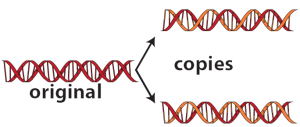
When cells reproduce themselves, they need to copy their DNA. That’s called replication.
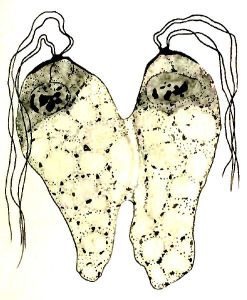
In organisms that consist of just one cell, DNA replication is one of the key parts of reproduction. To reproduce, a single-celled organism grows bigger, replicates its DNA, then divides itself in two. You can see a unicellular organism (Collodictyon) dividing into two at right.
For multicellular organisms like us, DNA replication is required for growth, repair and reproduction.
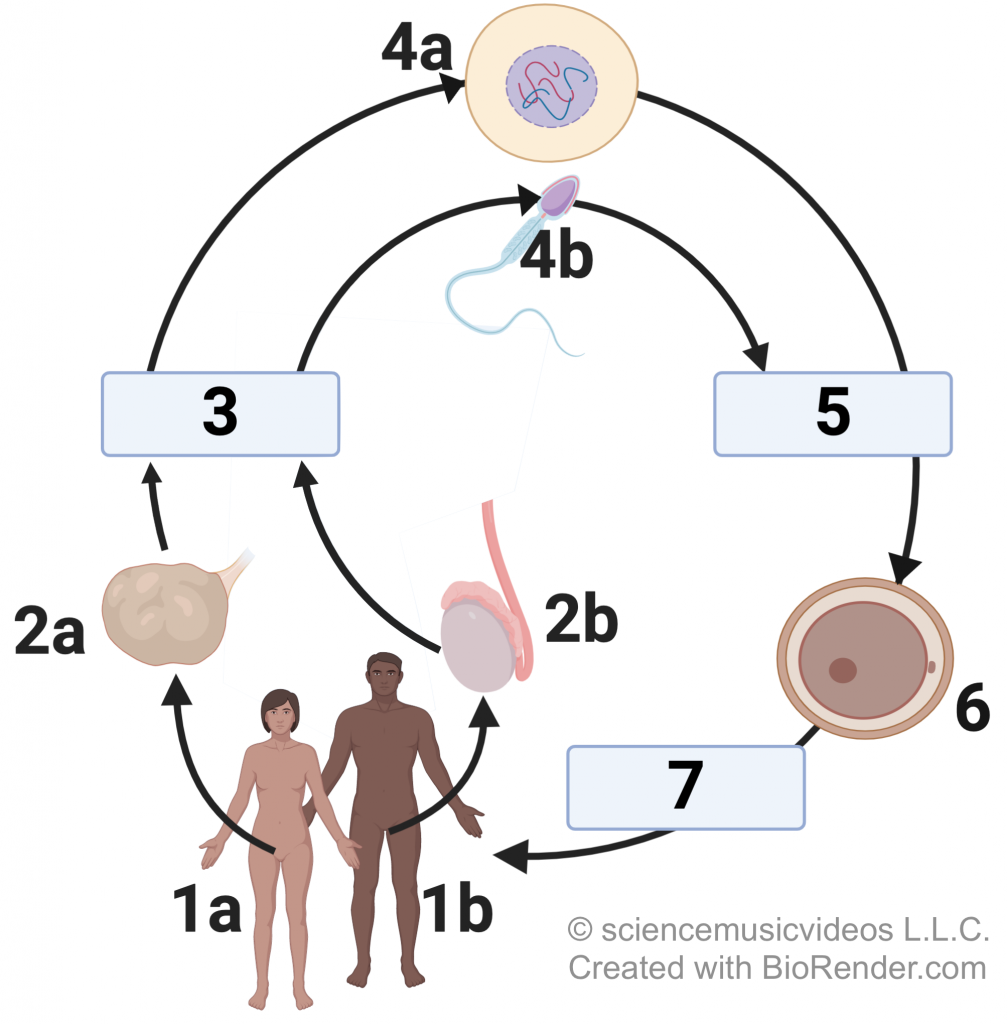 To return once again to your story, you didn’t become you until your father’s sperm (at 4b) fertilized your mother’s egg (at 4a). Fertilization (at 5) created a fertilized egg cell (at 6).
To return once again to your story, you didn’t become you until your father’s sperm (at 4b) fertilized your mother’s egg (at 4a). Fertilization (at 5) created a fertilized egg cell (at 6).
Now, some years later, you consist of trillions of cells (that’s you at 1a or 1b). Every time one of your cells divided to become two, all of the DNA in that cell had to be replicated. That process of DNA replication and cell division is indicated by “7.”
2b. DNA makes RNA makes protein: Transcription and Translation
DNA controls the cell by specifying which proteins the cell makes.
DNA is information. But on its own, a molecule of DNA is powerless. It can’t do anything, other than store information. By contrast, proteins can do things. For example, enzymes, which are made of protein, can take molecules apart or put them together. Muscle tissue, which is mostly made of protein, can make organisms move.
In terms of specifying proteins, here’s how DNA controls the cell.
-
- DNA stays in the nucleus. Through a process called transcription, messages from DNA are sent to the cytoplasm.
- These messages are in the form of RNA. We’ll learn about RNA later. For now, you just need to know that it’s a substance that’s closely related to DNA.
- Through a process called translation, RNA messages are changed into protein, the action molecule of the cell.
Just remember this: DNA gets transcribed into RNA, which gets translated into protein. Or, for short, DNA makes RNA makes Protein.
DNA makes RNA makes protein is a central idea in biology. In fact, it’s known as CENTRAL DOGMA of molecular genetics. Let’s take that apart. DOGMA means “an established opinion.” MOLECULAR GENETICS is the field that studies the molecules of heredity (like DNA and RNA). To say that “DNA makes RNA makes protein is a central dogma of molecular genetics” just means that it’s a super-important idea. In fact, it’s worth memorizing.
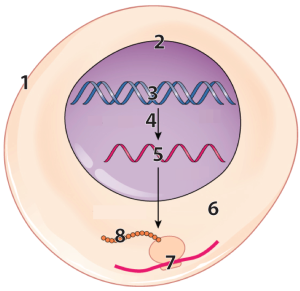 We’ll spend a lot of time clarifying replication, transcription, and translation in later tutorials. For now, lets’ study this diagram, which shows where these processes occur within cells.
We’ll spend a lot of time clarifying replication, transcription, and translation in later tutorials. For now, lets’ study this diagram, which shows where these processes occur within cells.
- The cell membrane is at 1. The nuclear membrane is at 2.
- DNA (3) gets transcribed (4) into RNA (5).
- The RNA leaves the nucleus and enters the cytoplasm (6)
- In the cytoplasm, RNA gets translated into protein (8). As we’ll see, translation happens at ribosomes (7)
DNA makes RNA makes protein is the essential recipe for life.
3. Where DNA is found
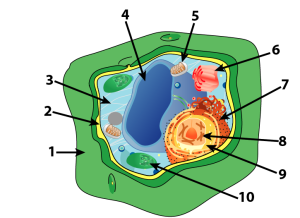
3a. In eukaryotic cells
In eukaryotic cells, most of the DNA is found in the chromosomes, within the nucleus. In the diagram of a plant cell to your left, the chromosomes are shown at number 8. (Note that this drawing is, by design, slightly inaccurate. Most of the time the DNA is spread throughout the nucleus. The “X” shaped chromosomes only appear when the cell is about to divide).
Two eukaryotic organelles, mitochondria (at 5) and chloroplasts (at 10), also have DNA. These organelles have DNA because they evolved from once-independent prokaryotic cells that long ago took up residence inside a larger, cell. That event, which occurred about two billion years ago, is how eukaryotic cells first evolved.
Because of their bacterial origins, the DNA in mitochondria and chloroplasts is similar to the prokaryotic DNA described below.
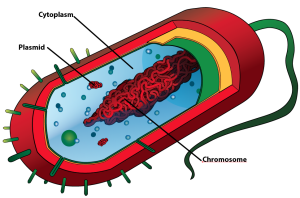
3b. In prokaryotic cells
Prokaryotic cells are found in two groups of organisms: bacteria and Archaea. These cells are very small. They don’t have a nucleus. They also lack the complex, membrane-bound organelles found in eukaryotic cells.
In prokaryotes, most of the DNA is found in the cytoplasm, in a single, looped chromosome. It’s looped because the end is connected to the beginning. Some additional DNA is located outside the main chromosome in small circles of DNA called plasmids. Bacterial cells use plasmids to exchange genes with one another. As we’ll see later in the course, plasmids are also essential tools for introducing new genes into bacteria during the process of genetic engineering.
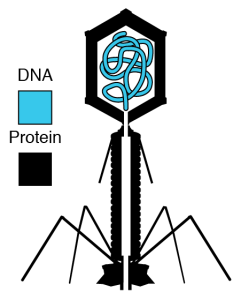 3.c. In viruses
3.c. In viruses
Viruses consist of DNA (or RNA) surrounded by protein. There can also be additional layers outside the protein. Viruses attack cells, and use the cell’s machinery to make more viruses.
3.d. At crime scenes
If you’ve watched any crime-related drama or read a detective novel from the last 30 years, you’ll see mention of “crime scene DNA,” or “DNA fingerprints.” Why is DNA so important in solving crimes?
Your DNA is unique to you. Your saliva contains DNA. So do your skin cells, which you’re constantly shedding. Blood and sperm contains DNA. That’s why one of the first things that detectives do at a crime scene is to swab surfaces to try to collect DNA. That DNA can be used to prove that a person was (or wasn’t) at a crime scene. Because DNA gets passed from parents to offspring, DNA can also be used to establish who someone’s parents are. That makes DNA one of the most powerful pieces of evidence in our legal system. We’ll learn more about this use of DNA in our unit on genetic engineering.
4. Why is it called DNA?
DNA stands for deoxyribonucleic acid. We’ll learn more about its chemical makeup in the next tutorial, but here’s what you need to know for now.
- The “deoxyribo-” part of deoxyribonucleic acid comes from a sugar that’s called deoxyribose. As you’ll see in the next tutorial, deoxyribose is a key part of DNA’s structure.
- The “-nucleic” part is about the fact that DNA is found in the nucleus of cells.
- The “acid” part is about the fact that when you add DNA to water, it creates an acidic solution.
That’s it. Take the quiz below to consolidate everything you’ve learned above.
5. Quiz: DNA, Key Concepts
[qwiz style = “border: 3px solid black; ” random = “false” qrecord_id=”sciencemusicvideosMeister1961-DNA, Key Concepts (HS)”]
[h] Quiz: DNA Concepts
[i]
[q labels = “top”]
[l]main bacterial chromosome
[fx] No, that’s not correct. Please try again.
[f*] Great!
[l]plasmid
[fx] No, that’s not correct. Please try again.
[f*] Correct!
[l]cytoplasm
[fx] No. Please try again.
[f*] Great!
[q labels = “top”]
[l]RNA
[fx] No, that’s not correct. Please try again.
[f*] Great!
[l]translation of RNA to protein
[fx] No, that’s not correct. Please try again.
[f*] Correct!
[l]DNA
[fx] No, that’s not correct. Please try again.
[f*] Excellent!
[l]cell membrane
[fx] No. Please try again.
[f*] Excellent!
[l]cytoplasm
[fx] No, that’s not correct. Please try again.
[f*] Good!
[l]protein
[fx] No, that’s not correct. Please try again.
[f*] Good!
[l]transcription of DNA to RNA
[fx] No, that’s not correct. Please try again.
[f*] Great!
[l]nuclear membrane
[fx] No, that’s not correct. Please try again.
[f*] Excellent!
[q labels = “top”]Label the four parts of a plant cell that have a direct connection to DNA.
[l]chromosomes
[fx] No, that’s not correct. Please try again.
[f*] Excellent!
[l]chloroplast
[fx] No, that’s not correct. Please try again.
[f*] Correct!
[l]mitochondria
[fx] No, that’s not correct. Please try again.
[f*] Correct!
[l]nuclear membrane
[fx] No. Please try again.
[f*] Great!
[q]Copying DNA is known as ____________
[c]dHJhbnNjcmlwdGlvbg==[Qq]
[c]cmVwbGlj YXRpb24=[Qq]
[c]dHJhbnNsYXRpb24=[Qq]
[f]Tm8uIFlvdSYjODIxNztyZSBsb29raW5nIGZvciB0aGXCoHdvcmQgdGhhdCYjODIxNztzwqB1c2VkIHdoZW4gc3Bva2VuIHdvcmRzwqBhcmUgY2hhbmdlZCBpbnRvIHdyaXR0ZW4gd29yZHM=[Qq]
[f]WWVzISBDb3B5aW5nIEROQSBpcyBrbm93biBhcyA=cmVwbGljYXRpb24u[Qq]
[f]Tm8uIFRyYW5zbGF0aW9uwqBpcyBtYWtpbmcgcHJvdGVpbsKgZnJvbSBSTkEu[Qq]
[q]The process of making RNA from DNA is known as ________
[c]dHJhbnNjcm lwdGlvbg==[Qq]
[c]cmVwbGljYXRpb24=[Qq]
[c]dHJhbnNsYXRpb24=[Qq]
[f]WWVzLiBUaGUgcHJvY2VzcyBvZiBtYWtpbmcgUk5BIGZyb20gRE5BIGlzIGtub3duIGFzIA==dHJhbnNjcmlwdGlvbg==Lg==[Qq]
[f]Tm8uIA==UmVwbGljYXRpb24=IG1lYW5zIA==Y29weWluZw==LiBZb3UmIzgyMTc7cmUgbG9va2luZyBmb3IgdGhlIHdvcmQgdGhhdCYjODIxNztzIHVzZWQgd2hlbiB5b3UgdGFrZSBhdWRpbyBhbmQgd3JpdGUgZG93biB0aGUgd29yZHMu[Qq]
[f]Tm8uIFRyYW5zbGF0aW9uIGludm9sdmVzIHRha2luZyBSTkEgYW5kIG1ha2luZyBpdCBpbnRvIHByb3RlaW4uIFlvdSYjODIxNztyZSBsb29raW5nIGZvciB0aGUgd29yZCB0aGF0JiM4MjE3O3MgdXNlZCB3aGVuIHlvdSB0YWtlIGF1ZGlvIGFuZCB3cml0ZSBkb3duIHRoZSB3b3Jkcy4=[Qq]
[q]The process of making protein based on RNA instructions is known as ________
[c]dHJhbnNjcmlwdGlvbg==[Qq]
[c]cmVwbGljYXRpb24=[Qq]
[c]dHJhbnNs YXRpb24=[Qq]
[f]Tm8uwqBUcmFuc2NyaXB0aW9uIGlzIG1ha2luZyBSTkEgZnJvbSBETkEuIFlvdSYjODIxNztyZSBsb29raW5nIGZvciB0aGUgd29yZCB0aGF0JiM4MjE3O3MgdXNlZCB3aGVuIHNvbWVvbmUgY2hhbmdlcyB0aGUgd29yZHMgaW4gb25lIGxhbmd1YWdlIGludG8gYW5vdGhlciBsYW5ndWFnZS4=[Qq]
[f]Tm8uIA==UmVwbGljYXRpb24=IG1lYW5zIA==Y29weWluZw==LllvdSYjODIxNztyZSBsb29raW5nIGZvciB0aGUgd29yZCB0aGF0JiM4MjE3O3MgdXNlZCB3aGVuIHNvbWVvbmUgY2hhbmdlcyB0aGUgd29yZHMgaW4gb25lIGxhbmd1YWdlIGludG8gYW5vdGhlciBsYW5ndWFnZS4=[Qq]
[f]WWVzLiBUcmFuc2xhdGlvbiBpbnZvbHZlcyB0YWtpbmcgUk5BIGFuZCBtYWtpbmcgaXQgaW50byBwcm90ZWluLg==[Qq]
[q]In the diagram below, DNA is shown at
[textentry single_char=”true”]
[c]Mw ==[Qq]
[f]WWVzLiBJbiB0aGUgZGlhZ3JhbSBhYm92ZSwgRE5BIGlzIHNob3duIGF0IDMu[Qq]
[c]Kg==[Qq]
[f]Tm8uIExvb2sgZm9yIHRoZSBkb3VibGUgaGVsaXgu[Qq]
[q]In the diagram below, RNA inside the nucleus is shown at
[textentry single_char=”true”]
[c]NQ ==[Qq]
[f]WWVzLiBJbiB0aGUgZGlhZ3JhbSBhYm92ZSwgUk5BIGluc2lkZSB0aGUgbnVjbGV1cyBpcyBzaG93biBhdCA1Lg==[Qq]
[c]Kg==[Qq]
[f]Tm8uIExvb2sgZm9yIGEgc2luZ2xlIGhlbGl4IChjb3Jrc2NyZXcgc2hhcGUpIGluc2lkZSB0aGUgbnVjbGV1cy4=[Qq]
[q]In the diagram below, newly made protein is shown at
[textentry single_char=”true”]
[c]OA ==[Qq]
[f]WWVzLiBJbiB0aGUgZGlhZ3JhbSBhYm92ZSzCoG5ld2x5IG1hZGUgcHJvdGVpbiBpcyBzaG93biBhdCA4Lg==[Qq]
[c]Kg==[Qq]
[f]Tm8uIExvb2sgc29tZXRoaW5nIGJlaW5nIG1hZGUgYnkgdGhlIHJpYm9zb21lIChzaG93biBhdCA3KQ==[Qq]
[q]In the diagram below, a ribosome is shown at
[textentry single_char=”true”]
[c]Nw ==[Qq]
[f]WWVzLiBJbiB0aGUgZGlhZ3JhbSBhYm92ZSwgYSByaWJvc29tZSBpcyBzaG93biBhdCA3[Qq]
[c]Kg==[Qq]
[f]Tm8uIExvb2sgZm9yIHNvbWV0aGluZyB0aGF0JiM4MjE3O3MgcmVhZGluZyBSTkEsIG1ha2luZyBwcm90ZWluLg==
Cg==[Qq]
[q]The central dogma of molecular genetics is ________ makes RNA, makes protein.
[hangman]
[c]RE5B[Qq]
[f]VGhlIGNlbnRyYWwgZG9nbWEgb2YgbW9sZWN1bGFyIGdlbmV0aWNzIGlzIA==RE5BIG1ha2VzIFJOQSwgbWFrZXMgcHJvdGVpbi4=
Cg==[Qq]
[q]The copying of DNA is called ________
[hangman]
[c]cmVwbGljYXRpb24=[Qq]
[f]VGhlIGNvcHlpbmcgb2YgRE5BIGlzIGNhbGxlZCA=cmVwbGljYXRpb24=Lg==
Cg==[Qq]
[q]The central dogma of molecular genetics is DNA makes RNA makes ____________.
[hangman]
[c]cHJvdGVpbg==[Qq]
[f]VGhlIGNlbnRyYWwgZG9nbWEgb2YgbW9sZWN1bGFyIGdlbmV0aWNzIGlzIEROQSBtYWtlcyBSTkEgbWFrZXMgcHJvdGVpbg==Lg==
Cg==[Qq]
[q]In a eukaryotic cell, DNA always stays in the __________________.
[hangman]
[c]bnVjbGV1cw==[Qq]
[f]WWVzISBJbiBhIGV1a2FyeW90aWMgY2VsbCwgRE5BIGFsd2F5cyBzdGF5cyBpbiB0aGUgbnVjbGV1cw==Lg==
Cg==Jm5ic3A7
[Qq][q]The word for the transfer of DNA information into RNA is ________________.
[hangman]
[c]dHJhbnNjcmlwdGlvbg==[Qq]
[f]VGhlIHdvcmQgZm9yIHRoZSB0cmFuc2ZlciBvZiBETkEgaW5mb3JtYXRpb24gaW50byBSTkEgaXMgdHJhbnNjcmlwdGlvbg==Lg==
Cg==[Qq]
[q]The word for the transfer of RNA information into protein is ________________.
[hangman]
[c]dHJhbnNsYXRpb24=[Qq]
[f]TmljZSEgVGhlIHdvcmQgZm9yIHRoZSB0cmFuc2ZlciBvZiBSTkEgaW5mb3JtYXRpb24gaW50byBwcm90ZWluIGlzIA==dHJhbnNsYXRpb24=Lg==
Cg==[Qq]
[q]The “action molecule” of the cell is ___________________.
[hangman]
[c]cHJvdGVpbg==[Qq]
[f]Q29ycmVjdC4gVGhlIOKAnGFjdGlvbiBtb2xlY3VsZeKAnSBvZiB0aGUgY2VsbCBpcyA=cHJvdGVpbg==Lg==
Cg==[Qq]
[q]The molecule which brings DNA information to the cytoplasm is _______
[hangman]
[c]Uk5B[Qq]
[f]R29vZCBqb2IhIFRoZSBtb2xlY3VsZSB3aGljaCBicmluZ3MgRE5BIGluZm9ybWF0aW9uIHRvIHRoZSBjeXRvcGxhc20gaXMgUk5BLg==
Cg==[Qq]
[q]In a eukaryotic cell, the DNA is organized into multiple ______________.
[hangman]
[c]Y2hyb21vc29tZXM=[Qq]
[f]WWVzLiBJbiBhIGV1a2FyeW90aWMgY2VsbCwgdGhlIEROQSBpcyBvcmdhbml6ZWQgaW50byBtdWx0aXBsZSA=Y2hyb21vc29tZXM=Lg==
Cg==Jm5ic3A7
[Qq]
[q]This tiny particle attacks cells. It can have DNA or RNA as its genetic material. It’ a ______________
[hangman]
[c]dmlydXM=[Qq]
[f]WWVzLiBBIHRpbnksIGNlbGwtYXR0YWNraW5nIHBhcnRpY2xlIHdoaWNoIGNhbiBoYXZlIEROQSBvciBSTkEgYXMgaXRzIGdlbmV0aWMgbWF0ZXJpYWwgaXMgYSA=dmlydXM=
Cg==[Qq]
[q]Of the choices below, which is the only animal cell organelle that contains its own DNA?
[c]MiDCoCDCoCDCoA==[Qq][c]MyDCoCDCoCDCoA==[Qq][c]NiDCoCDCoCDCoA==[Qq][c]NyDCoCDC oCDCoA==[Qq][c]OCDCoCDCoCDCoA==[Qq][c]OQ==
Cg==[Qq][f]Tm8uIE51bWJlciAyIGlzIHBvaW50aW5nIHRvIHRoZSBjZWxsIG1lbWJyYW5lLiBUaGVyZSYjODIxNztzIG5vIEROQSB0aGVyZS4=[Qq]
[f]Tm8uIE51bWJlciAzIGlzIHBvaW50aW5nIHRvIHRoZSBnb2xnaSBhcHBhcmF0dXMuIFRoZXJlJiM4MjE3O3Mgbm8gRE5BIHRoZXJlLg==[Qq]
[f]Tm8uIE51bWJlciA2IGlzIHBvaW50aW5nIHRvIHRoZSByaWJvc29tZXMuIFRoZXkmIzgyMTc7cmUgbWFkZSBvZiBSTkEsIG5vdCBETkEu[Qq]
[f]WWVzLiBOdW1iZXIgNyBpcyBwb2ludGluZyBhIG1pdG9jaG9uZHJpb24uIE1pdG9jaG9uZHJpYSBldm9sdmVkIGZyb20gZnJlZSBsaXZpbmcgYmFjdGVyaWFsIGNlbGxzLCBhbmQgaGF2ZSB0aGVpciBvd24gRE5BLg==[Qq]
[f]Tm8uIE51bWJlciA4wqBpcyBwb2ludGluZyB0byB0aGUgY2VudHJpb2xlcy4gVGhlcmUmIzgyMTc7cyBubyBETkEgdGhlcmUu[Qq]
[f]Tm8uIE51bWJlciA5wqBpcyBwb2ludGluZyB0byB0aGUgRW5kb3BsYXNtaWMgUmV0aWN1bHVtLiBUaGVyZSYjODIxNztzIG5vIEROQSB0aGVyZS4=
Cg==Cg==[Qq][q]In a plant cell, which of the following organelles DOES NOT have DNA.
[c]bWl0b2Nob25kcmlvbg==[Qq]
[c]Y2hsb3JvcGxhc3Q=[Qq]
[c]bnVjbGV1cw==[Qq]
[c]Z29sZ2kgYX BwYXJhdHVz[Qq]
[f]Tm8uIFRoZSBtaXRvY2hvbmRyaW9uLCB3aGljaCBpcyBhbiBldm9sdXRpb25hcnkgZGVzY2VuZGFudCBvZiBhbsKgaW5kZXBlbmRlbnQgcHJva2FyeW90aWMgY2VsbCwgY29udGFpbnMgaXRzIG93biBETkEu[Qq]
[f]Tm8uIFRoZSBjaGxvcm9wbGFzdCwgd2hpY2ggaXMgYW4gZXZvbHV0aW9uYXJ5IGRlc2NlbmRhbnQgb2YgYW4gaW5kZXBlbmRlbnQsIHBob3Rvc3ludGhldGljIHByb2thcnlvdGljIGNlbGwsIGNvbnRhaW5zIGl0cyBvd24gRE5BLg==[Qq]
[f]Tm8uIFRoZSBudWNsZXVzIGlzIHRoZSBtYWluIHN0b3JlaG91c2Ugb2YgdGhlIGNlbGwmIzgyMTc7cyBETkEu[Qq]
[f]WWVzLiBUaGUgR29sZ2kgYXBwYXJhdHVzIGlzIG9uZSBvZiBtYW55IGNlbGwgb3JnYW5lbGxlcyB0aGF0IGRvZXMgTk9UwqBjb250YWluIGl0cyBvd24gRE5BLg==
Cg==Cg==[Qq][q]In a eukaryotic cell, chromosomes are located in the
[c]Q2VsbCBtZW1icmFuZQ==[Qq]
[c]bnVjbG V1cw==[Qq]
[c]ZW5kb3BsYXNtaWMgcmV0aWN1bHVt[Qq]
[c]cmlib3NvbWVz[Qq]
[f]Tm8uIEluIGEgZXVrYXJ5b3RpY8KgY2VsbCwgY2hyb21vc29tZXMgYXJlIGxvY2F0ZWQgaW4gYSBtZW1icmFuZS1ib3VuZCBvcmdhbmVsbGUgaW4gdGhlIGNlbnRlciBvZiB0aGUgY2VsbC4gV2hhdCB3b3VsZCB0aGF0IGJlPw==
Cg==[Qq]
[f]WWVzLiBJbiBhIGV1a2FyeW90aWMgY2VsbCwgY2hyb21vc29tZXMgYXJlIGxvY2F0ZWQgaW4gdGhlIG51Y2xldXMu
Cg==[Qq]
[f]Tm8uIEluIGFldWthcnlvdGljwqBjZWxsLCBjaHJvbW9zb21lcyBhcmUgbG9jYXRlZCBpbiBhIG1lbWJyYW5lLWJvdW5kIG9yZ2FuZWxsZSBpbiB0aGUgY2VudGVyIG9mIHRoZSBjZWxsLiBXaGF0IHdvdWxkIHRoYXQgYmU/
Cg==[Qq]
[f]Tm8uIEluIGEgZXVrYXJ5b3RpY8KgY2VsbCwgY2hyb21vc29tZXMgYXJlIGxvY2F0ZWQgaW4gYSBtZW1icmFuZS1ib3VuZCBvcmdhbmVsbGUgaW4gdGhlIGNlbnRlciBvZiB0aGUgY2VsbC4gV2hhdCB3b3VsZCB0aGF0IGJlPw==
Cg==Cg==[Qq]
[q]The diagram below represents
[c]cmVwbGlj YXRpb24=[Qq]
[c]dHJhbnNjcmlwdGlvbg==[Qq]
[c]dHJhbnNsYXRpb24=[Qq]
[f]WWVzLiBSZXBsaWNhdGlvbiBpcyB0aGUgY29weWluZyBvZiBuZXcgRE5BIGZyb20gcGFyZW50IEROQS4=[Qq]
[f]Tm8uIFRyYW5zY3JpcHRpb24gaXMgdGhlIHRyYW5zZmVyIG9mIEROQSBpbmZvcm1hdGlvbiBpbnRvIFJOQS4=[Qq]
[f]Tm8uIFRyYW5zbGF0aW9uIGlzIHRoZSB0cmFuc2ZlciBvZiBSTkEgaW5mb3JtYXRpb24gaW50byBwcm90ZWluLg==
[q]In the diagram below, the only number that’s directly connected to translation is
[c]McKgwqAg[Qq][c]MsKgwqAg[Qq][c]MyDCoA==[Qq][c]NMKgwqDCoMKgIA==[Qq][c]NcKgwqDCoMKgIA==[Qq][c]NsKgwqDCoMKgIA==[Qq][c]Nw ==
[f]Tm8uIDEgcmVwcmVzZW50cyB0aGUgY2VsbCBtZW1icmFuZS7CoA==VHJhbnNsYXRpb24=IGlzIHdoZW4gaW5zdHJ1Y3Rpb25zIGluIFJOQSBhcmUgY29udmVydGVkIGludG8gcHJvdGVpbi4gV2hpY2ggbnVtYmVyIGNvdWxkIHJlcHJlc2VudCB0aGlzIHByb2Nlc3M/[Qq]
[f]Tm8uIDIgcmVwcmVzZW50cyB0aGUgbnVjbGVhciBtZW1icmFuZS7CoA==VHJhbnNsYXRpb24=IGlzIHdoZW4gaW5zdHJ1Y3Rpb25zIGluIFJOQSBhcmUgY29udmVydGVkIGludG8gcHJvdGVpbi4gV2hpY2ggbnVtYmVyIGNvdWxkIHJlcHJlc2VudCB0aGlzIHByb2Nlc3M/[Qq]
[f]Tm8uIDMgcmVwcmVzZW50cyBETkEuwqA=VHJhbnNsYXRpb24=IGlzIHdoZW4gaW5zdHJ1Y3Rpb25zIGluIFJOQSBhcmUgY29udmVydGVkIGludG8gcHJvdGVpbi4gV2hpY2ggbnVtYmVyIGNvdWxkIHJlcHJlc2VudCB0aGlzIHByb2Nlc3M/[Qq]
[f]Tm8uIDQgcmVwcmVzZW50cyB0cmFuc2NyaXB0aW9uLiBEdXJpbmcgdHJhbnNjcmlwdGlvbiwgRE5BIGluZm9ybWF0aW9uIGlzIHRyYW5zZmVycmVkIHRvIFJOQS7CoA==VHJhbnNsYXRpb24=IGlzIHdoZW4gaW5zdHJ1Y3Rpb25zIGluIFJOQSBhcmUgY29udmVydGVkIGludG8gcHJvdGVpbi4gV2hpY2ggbnVtYmVyIGNvdWxkIHJlcHJlc2VudCB0aGlzIHByb2Nlc3M/[Qq]
[f]Tm8gKGJ1dCB5b3UmIzgyMTc7cmUgY2xvc2UpLiA1IHJlcHJlc2VudHMgUk5BLsKgVHJhbnNsYXRpb24=IGlzIHdoZW4gaW5zdHJ1Y3Rpb25zIGluIFJOQSBhcmUgY29udmVydGVkIGludG8gcHJvdGVpbi4gV2hpY2ggbnVtYmVyIGNvdWxkIHJlcHJlc2VudCB0aGlzIHByb2Nlc3M/[Qq]
[f]Tm8uIDYgcmVwcmVzZW50cyB0aGUgY3l0b3BsYXNtLsKgVHJhbnNsYXRpb24=IGlzIHdoZW4gaW5zdHJ1Y3Rpb25zIGluIFJOQSBhcmUgY29udmVydGVkIGludG8gcHJvdGVpbi4gV2hpY2ggbnVtYmVyIGNvdWxkIHJlcHJlc2VudCB0aGlzIHByb2Nlc3M/[Qq]
[f]WWVzLiA3IHJlcHJlc2VudHMgdHJhbnNsYXRpb24sIG9yIHByb3RlaW4gc3ludGhlc2lzLsKgVHJhbnNsYXRpb24=IGlzIHdoZW4gaW5zdHJ1Y3Rpb25zIGluIFJOQSBhcmUgY29udmVydGVkIGludG8gcHJvdGVpbi4=
Cg==[Qq][q]Which number is pointing to the main bacterial chromosome?
[c]MQ==[Qq]
[c]Mg==[Qq]
[c]Mw ==[Qq]
[f]Tm8uIDEgaXMgcG9pbnRpbmcgdG8gYSBwbGFzbWlkLg==[Qq]
[f]Tm8uIDIgaXMgcG9pbnRpbmcgdG8gdGhlIGN5dG9wbGFzbS4=[Qq]
[f]WWVzLiAzIGlzIHBvaW50aW5nIHRvIHRoZSBtYWluIGJhY3RlcmlhbMKgY2hyb21vc29tZS4=
[q]Your genes are made of
[c]cHJvdGVpbg==[Qq]
[c]RE 5B[Qq]
[c]Uk5B[Qq]
[f]Tm8uIFlvdXIgZ2VuZXMgY29kZQ==IGZvciBwcm90ZWluLCBidXQgdGhleSYjODIxNztyZSBub3QgbWFkZSBvZiBETkEu[Qq]
[f]WWVzLiDCoFlvdXIgZ2VuZXMgYXJlIG1hZGUgb2YgRE5BLg==[Qq]
[f]Tm8uIFJOQSBpcyBhIG1lc3NlbmdlciBvZiBnZW5ldGljIGluZm9ybWF0aW9uLiBXaGF0IGlzIHRoZSBtb2xlY3VsZSB0aGF0IGhhcyB0aGUgZ2VuZXRpYyBpbmZvcm1hdGlvbiB0aGF0IHlvdSBpbmhlcml0Lg==
Cg==Cg==[Qq][q]The phrase “DNA makes RNA makes protein” is also known as the _______ of molecular genetics.
[c]Y29yZSBjb25jZXB0[Qq]
[c]a2V5IGlkZWE=[Qq]
[c]Y2VudHJhbC Bkb2dtYQ==[Qq]
[f]Tm8uICYjODIyMDtETkEgbWFrZXMgUk5BIG1ha2VzIHByb3RlaW4mIzgyMjE7IGlzIGEgY29yZSBjb25jZXB0IGluIG1vbGVjdWxhciBnZW5ldGljcywgYnV0IHRoaXMgY29uY2VwdCBpcyBzbyBpbXBvcnRhbnQgdGhhdCBpdCBoYXMgYSBzcGVjaWFsIG5hbWUu[Qq]
[f]Tm8uICYjODIyMDtETkEgbWFrZXMgUk5BIG1ha2VzIHByb3RlaW4mIzgyMjE7IGlzIGEga2V5IGlkZWEgaW4gbW9sZWN1bGFyIGdlbmV0aWNzLCBidXQgdGhpcyBjb25jZXB0IGlzIHNvIGltcG9ydGFudCB0aGF0IGl0IGhhcyBhIHNwZWNpYWwgbmFtZS4=[Qq]
[f]WWVzLiAmIzgyMjA7RE5BIG1ha2VzIFJOQSBtYWtlcyBwcm90ZWluJiM4MjIxOyBpc8KgdGhlIGNlbnRyYWwgZG9nbWEgb2YgbW9sZWN1bGFyIGdlbmV0aWNzLg==[Qq]
[q] _______ always stays in the nucleus. It controls the cell by sending out messages in the form of _______
[c]Uk5B4oCmLnByb3RlaW4=[Qq]
[c]RE5BJiM4MjMwO3Byb3RlaW4=[Qq]
[c]Uk5BJiM4MjMwO0ROQQ==[Qq]
[c]RE5BJiM4Mj MwO1JOQQ==[Qq]
[f]Tm8uIFJOQSBpcyB0cmFuc2NyaWJlZCBpbiB0aGUgbnVjbGV1cyBhbmQgdGhlbiBtb3ZlcyB0byB0aGUgY3l0b3BsYXNtLg==[Qq]
[f]Tm8uIFlvdSYjODIxNztyZSByaWdodCBhYm91dCBETkEsIGJ1dCB0aGVyZSYjODIxNztzIGFub3RoZXIgbW9sZWN1bGUgdGhhdCBicmluZ3MgRE5BJiM4MjE3O3MgbWVzc2FnZXMgb3V0IHRvIHRoZSBjeXRvcGxhc20u[Qq]
[f]Tm8uIFlvdSYjODIxNzt2ZSBnb3QgdGhlIHR3byByZXZlcnNlZC4=[Qq]
[f]WWVzIcKgRE5BwqBhbHdheXMgc3RheXMgaW4gdGhlIG51Y2xldXMuIEl0IGNvbnRyb2xzIHRoZSBjZWxsIGJ5IHNlbmRpbmcgb3V0IG1lc3NhZ2VzIGluIHRoZSBmb3JtIG9mIA==Uk5BLg==
[Qq][q]If a cell were an office, the molecule that would act like a boss who always stays in the office would be
[c]cHJvdGVpbg==[Qq]
[c]RE 5B[Qq]
[c]Uk5B[Qq]
[f]Tm8uIFByb3RlaW4gaXMgdGhlIHdvcmtlciBtb2xlY3VsZSBpbiB0aGUgY2VsbC4gV2hvJiM4MjE3O3MgdGhlIGJvc3M/[Qq]
[f]WWVzLiBETkEsIGluIGV1a2FyeW90aWMgY2VsbHMsIGFsd2F5cyBzdGF5cyBpbiB0aGUgbnVjbGV1cy4gVGhhdCBtYWtlcyBpdCBzb21ld2hhdCBsaWtlwqBhIGJvc3Mgd2hvIGFsd2F5cyBzdGF5cyBpbiB0aGUgb2ZmaWNlLg==[Qq]
[f]Tm8uIFJOQSBpcyBhbHdheXMgbW92aW5nIGZyb20gdGhlIG51Y2xldXMgdG8gdGhlIGN5dG9wbGFzbS4gSWYgdGhlIG51Y2xldXMgd2VyZSB0aGUgb2ZmaWNlLCB0aGVuIHRoaXMgYW5hbG9neSBkb2VzbiYjODIxNzt0IGZpdC4=
Cg==Cg==[Qq][q]In the diagram below, transcription is represented by which number?
[c]McKgwqAg[Qq][c]MsKgwqAg[Qq][c]MyDCoA==[Qq][c]NMKgwqDC oMKgIA==[Qq][c]NcKgwqDCoMKgIA==[Qq][c]NsKgwqDCoMKgIA==[Qq][c]N8KgwqDCoMKgIA==[Qq][c]OA==
[f]Tm8uIDEgcmVwcmVzZW50cyB0aGUgY2VsbCBtZW1icmFuZS7CoER1cmluZyA=dHJhbnNjcmlwdGlvbg==LCBETkEgaW5mb3JtYXRpb24gaXMgdHJhbnNmZXJyZWQgdG8gUk5BLiBXaGljaCBudW1iZXIgY291bGQgcmVwcmVzZW50IHRoaXMgdHJhbnNmZXI/[Qq]
[f]Tm8uIDIgcmVwcmVzZW50cyB0aGUgbnVjbGVhciBtZW1icmFuZS7CoER1cmluZyA=dHJhbnNjcmlwdGlvbg==LCBETkEgaW5mb3JtYXRpb24gaXMgdHJhbnNmZXJyZWQgdG8gUk5BLiBXaGljaCBudW1iZXIgY291bGQgcmVwcmVzZW50IHRoaXMgdHJhbnNmZXI/[Qq]
[f]Tm8uIDMgcmVwcmVzZW50cyBETkEuwqBEdXJpbmcgdHJhbnNjcmlwdGlvbg==LCBETkEgaW5mb3JtYXRpb24gaXMgdHJhbnNmZXJyZWQgdG8gUk5BLiBXaGljaCBudW1iZXIgY291bGQgcmVwcmVzZW50IHRoaXMgdHJhbnNmZXI/[Qq]
[f]WWVzLiA0IHJlcHJlc2VudHMgdHJhbnNjcmlwdGlvbi4gRHVyaW5nIHRyYW5zY3JpcHRpb24sIEROQSBpbmZvcm1hdGlvbiBpcyB0cmFuc2ZlcnJlZCB0byBSTkEu[Qq]
[f]Tm8gKGJ1dCB5b3UmIzgyMTc7cmUgY2xvc2UpLiA1IHJlcHJlc2VudHMgUk5BLsKgRHVyaW5nIA==dHJhbnNjcmlwdGlvbg==LCBETkEgaW5mb3JtYXRpb24gaXMgdHJhbnNmZXJyZWQgdG8gUk5BLiBXaGljaCBudW1iZXIgY291bGQgcmVwcmVzZW50IHRoaXMgdHJhbnNmZXI/[Qq]
[f]Tm8uIDYgcmVwcmVzZW50cyB0aGUgY3l0b3BsYXNtLsKgRHVyaW5nIA==dHJhbnNjcmlwdGlvbg==LCBETkEgaW5mb3JtYXRpb24gaXMgdHJhbnNmZXJyZWQgdG8gUk5BLiBXaGljaCBudW1iZXIgY291bGQgcmVwcmVzZW50IHRoaXMgdHJhbnNmZXI/[Qq]
[f]Tm8uIDcgcmVwcmVzZW50cyB0cmFuc2xhdGlvbiwgb3IgcHJvdGVpbiBzeW50aGVzaXMuwqBEdXJpbmcgdHJhbnNjcmlwdGlvbg==LCBETkEgaW5mb3JtYXRpb24gaXMgdHJhbnNmZXJyZWQgdG8gUk5BLiBXaGljaCBudW1iZXIgY291bGQgcmVwcmVzZW50IHRoaXMgdHJhbnNmZXI/[Qq]
[f]Tm8uIDjCoHJlcHJlc2VudHMgYSBwcm90ZWluLCB3aGljaCBpcyB0aGUgcHJvZHVjdCBvZiB0cmFuc2xhdGlvbi7CoER1cmluZyA=dHJhbnNjcmlwdGlvbg==LCBETkEgaW5mb3JtYXRpb24gaXMgdHJhbnNmZXJyZWQgdG8gUk5BLiBXaGljaCBudW1iZXIgY291bGQgcmVwcmVzZW50IHRoaXMgdHJhbnNmZXI/[Qq]
[x]
If you want to take this quiz again, click the button below
[restart]
[/qwiz]
5. Next Steps
- DNA structure (the next HS level tutorial in this series)
- DNA tutorials (HS Level) menu
- DNA, Fantastic! (music video page)
